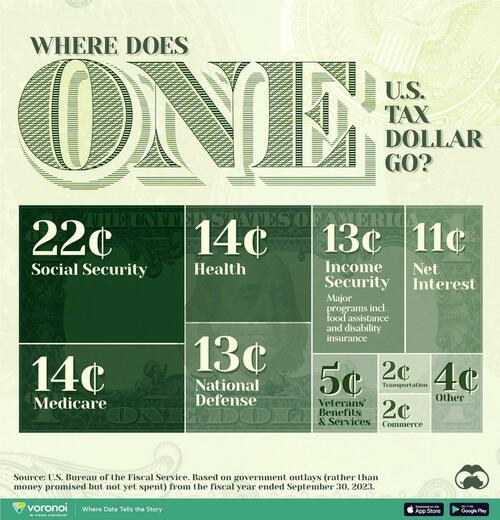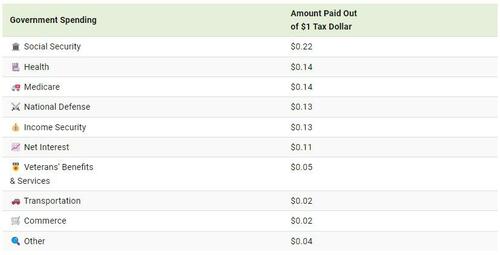As they keep spending a lot of money we don’t have, that interest percentage is going to grow by a lot. Though, with the gene therapy and taking over medical treatment protocols (killing people), they’re reducing the numbers of the elderly to lower the first three. If you think about it, they might be compensating for the rise in the interest payments. And fiscally responsible people with capital have been dropping out of the work force, so one could argue the influx of illegal immigrants are meant to create more taxpayers. However it goes, it’s a disaster that can’t be fixed nor is there any desire to do so.

https://www.zerohedge.com/personal-finance/where-does-one-us-tax-dollar-go
by Tyler Durden
Come tax season, a common refrain is: “what do my taxes even pay for?”
To answer that question, Visual Capitalist’s Marcus Lu visualized U.S. federal government spending by function, referencing expenditure to a single federal tax dollar.

Data is for the fiscal year ending September 30, 2023 from the U.S. Bureau of the Fiscal Service. Total spending amounts are converted to cents on the dollar and percentages, to show where one tax dollar goes.
Major Areas of U.S. Government Spending
Social security is the government’s single largest expense and where 22% of tax dollars go. Signed into law in 1935, the program was to insure against the “hazards and vicissitudes of life.” In practice, it meant the creation of a work-related contributory system in which workers secure their own retirement by taxes paid while employed.
However, an aging population threatens its sustainability because as more people retire and draw benefits, there are fewer active workers contributing to the system.

Health and Medicare together amount to 28% of government spending. The largest health expense is grants to states for Medicaid, which helps cover medical costs for people with lower incomes. Medicare, on the other hand, is federal health insurance for people 65 and older, as well as younger people with disabilities.
National Defense accounts for 13% of government spending. This includes paying military personnel, operating and maintenance costs like fuel, buying aircraft and ships, and research and development. While fourth in terms of percentage spending, this still contributes to the largest military budget in the world—by quite a margin.
Meanwhile, Income Security (also at 13%) covers programs like unemployment compensation, nutrition assistance, and housing assistance. It also has additional retirement and disability benefits not covered by social security.
Just behind—and still well-ahead of all other government spending—is Interest Payments on government debt, coming in at about 11% of tax supported expenditure.